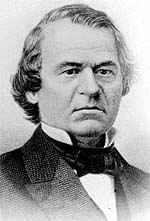1952 First transistorized hearing aid goes on sale, by the Sonotone Corporation, in Elmsford NY. The 8-cm-long device weighs about 100 grams. The first hearing aid (other than an ear trumpet) was the Audiophone, a device held against the teeth, which was patented in 1879. An electric hearing aid was produced in 1901.
1922 William Gaddis, US novelist who died on 16 December 1998.
1917 Tom Bradley (Mayor-D-LA) (1973- )
| 1916 Portrait of the Artist
as a Young Man by James Joyce is published in
New York. It had been previously serialized in Ezra Pound's review
The Egoist. James Joyce was born in Dublin on 2 February 1882, the eldest of 10 children of a cheerful ne'er-do-well who eventually went bankrupt. Joyce attended Catholic school and University College in Dublin, where he learned Dano-Norwegian so he could read the plays of Henrik Ibsen in the original. In college, he began a lifetime of literary rebellion, self-publishing an essay rejected by the school's literary magazine adviser. After graduation, Joyce moved to Paris. He resolved to study medicine to support himself while writing but soon gave it up. He returned to Dublin to visit his mother's deathbed and remained to teach school and work odd jobs. On June 16, 1904, he met Nora, whom he convinced to return to Europe with him. The couple settled in Trieste, where they had two children, and then in Zurich. Joyce struggled with serious eye problems, undergoing 25 operations for various troubles between 1917 and 1930. In 1914, he published The Dubliners , and his 1915 novel, Portrait of the Artist as a Young Man, brought him fame and the patronage of several wealthy people, including Edith Rockefeller. In 1918, his revolutionary stream of consciousness novel Ulysses began to be serialized in the American journal Little Review. However, the US Post Office stopped the publication's distribution in December of that year on the grounds that the novel was obscene. Sylvia Beach, owner of bookstore Shakespeare and Co. in Paris, where Joyce moved in 1920, published the novel herself in 1922, but it was banned in the United Kingdom, and, until a 6 December 1933 court ruling, in the United States. Joyce's final novel, Finnegans Wake, was published in 1939, and Joyce died in 1941. more JOYCE ONLINE: Dubliners at another site, Chamber Music, Chamber Music. |
1911 Klaus Fuchs, German-born US physicist and spy, who died on 28 January 1988.
1908 Four-wheel braking system is patented by Otto Zachow and William Besserdich of Clintonville, Wisconsin. It is the prototype of all modern braking systems.
1896 David Alfaro Siqueiros Mexico, painter/muralist (Lib of Chile)
| 1891 Wireless radio
is patented by Edison. Thomas Edison is granted a patent for wireless radio. The patent is for "a means for transmitting signals electrically.” His patent indicated that signals could be transmitted between two points without a wire. By the end of his life, Edison held a record number of patents, including more than 300 for electric light and power, nearly 200 for the phonograph, 150 for the telegraph, 141 for storage batteries, and several dozen for the telephone. He also developed key components of motion picture technology. |
 1879
William “Billy” Mitchell, US Army general (WW I), early
advocate of a separate air force. He died on 19 February 1936.
1879
William “Billy” Mitchell, US Army general (WW I), early
advocate of a separate air force. He died on 19 February 1936.1876 Pablo Casals, Vendrell, Catalonia, Spain, cellist/conductor/composer.
1868 Ludwig Ferdinand Graf, German artist who died in 1932.
1861 Kurt Hensel, mathematician.
1859 Venustiano Carranza President of Mexico (1915-20).
1859 Elizabeth Adela (Amstrong, Stanhope, Alexander) Forbes, British artist who died on 22 March 1912. — LINKS
1856 Thomas J. Stieltjes, mathematician (Stieltjes integral)
1851 The first US Young Men's Christian Association is organized, in Boston.
1841 Alexander Carlovich Beggrow, Russian artist who died in 1914.
1838 Raffaello Sernesi, Italian artist who died on 11 August 1866.
1834 Auguste Louis Veillon, Swiss artist who died on 05 January 1890.
1809 William Ewart Gladstone (Lib) British prime minister four times (1868-74, 1880-85, 1886, 1892-94). He died on 19 May 1898.
1808 Andrew Johnson [< photo], Raleigh NC, (Unionist), 17th President (1865-69) succeeded Lincoln after the 15 April 1865 assassination. First American president to be impeached. He died on 31 July 1875.
| 1800 Charles Goodyear
He would become famous for the invention of vulcanized rubber. In its natural form, rubber is sticky, and gets runny when hot and stiff when cold. Goodyear discovered (accidentally) that when rubber is mixed with sulfur and heat-treated, it loses its adhesiveness but keeps its elasticity, even at extreme temperatures. He called the process "vulcanization.” The industrial use of rubber is possible only because of vulcanization. Goodyear's process made millions of dollars, but not for him. Widespread infringements on his patents, together with poor luck in business, left him deep in debt at his death on 01 July 1860. |
1759 Julius-César Ibbetson, British painter who died on 13 October 1817. — LINKS — Going to Market (1785) — Returning from Market (1785)
1721 Jeanne Poisson Marquise de Pompadour, influential mistress of Louis XV, who was later blamed for France's defeat in the Seven Years' War. She died on 15 April 1764.
1695 Jean-Baptiste Joseph Pater, French painter who died on 25 July 1736. . — MORE ON PATER AT ART “4” DECEMBER — LINKS — The Offer of Flowers (Springtime) — Fête Champêtre — another Fête Champètre (15x20cm) — Concert Champêtre — The Chinese Hunt